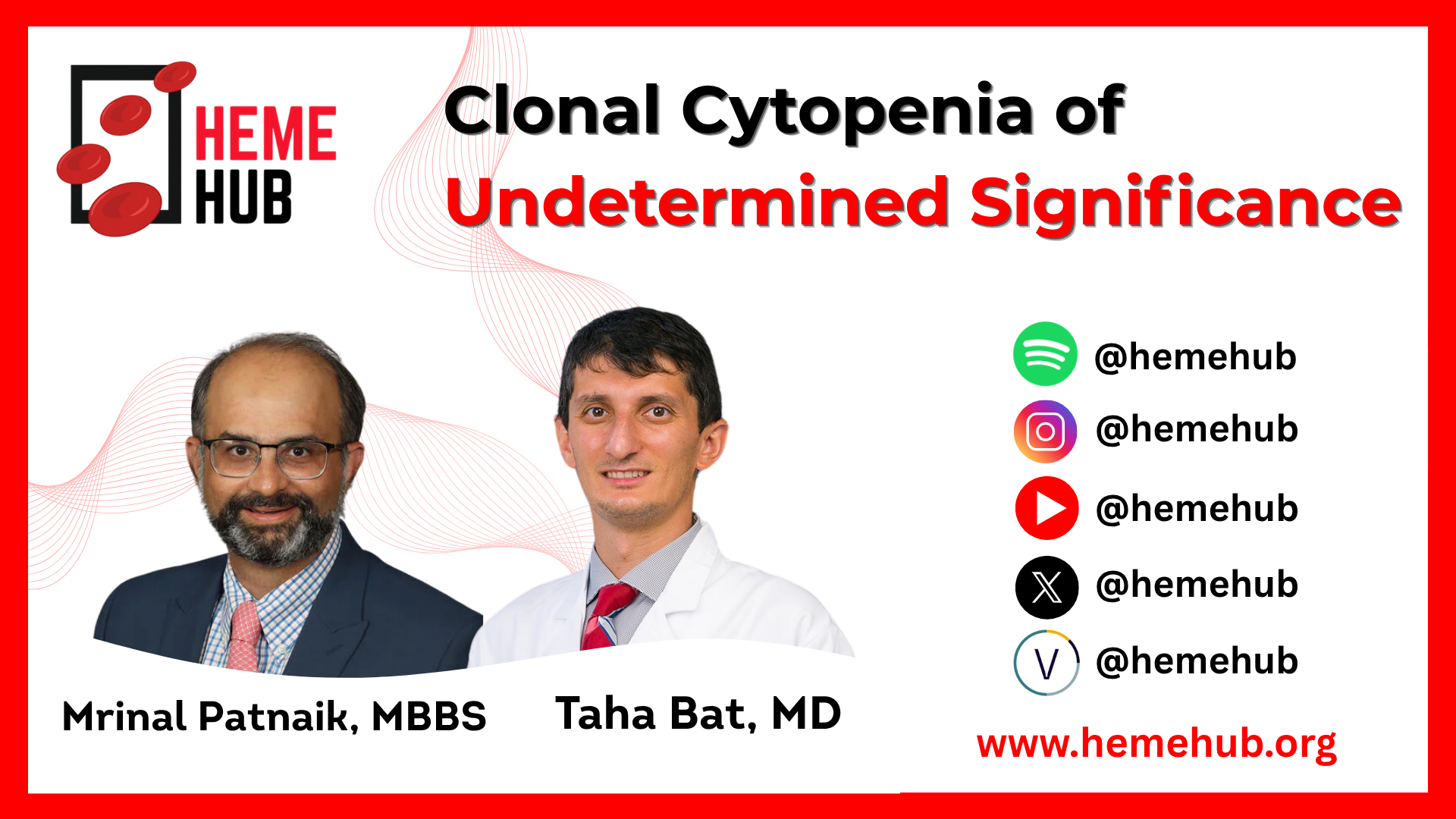4 videos available in myeloid disorders

CCUS vs MDS
This video features Mrinal Patnaik, MD of Mayo Clinic and Taha Bat, MD discussing clonal cytopenias of undetermined significance (CCUS) and myelodysplastic syndromes (MDS), covering diagnostic criteria, management strategies, and the clinical implications of clonal hematopoiesis. Mrinal Patnaik, MD delves into the nuances of distinguishing between these conditions and their impact on treatment access. The session covers the importance of clinical correlation, detailed considerations for clonal hematopoiesis workup in patients with solid malignancies, and the rationale behind the 2% Variant Allele Fraction (VAF) cutoff. The discussion highlights risk stratification models, MDS-defining cytogenetic abnormalities, and explores clinical implications beyond cytopenia, including inflammatory symptoms and increased cardiovascular risk.
Key Learning Points:
- CCUS and MDS distinction can be subtle, relying on dysplasia levels and clonal abnormalities
- A CCUS diagnosis can hinder access to medications due to ICD10 coding limitations
- Clinical correlation and a holistic approach are vital; some CCUS patients experience morbidity similar to low-risk MDS
- +10 more points...

Essential Thrombocythemia
This video features a discussion between Ayalew Tefferi, MD, a Professor of Medicine and leading hematologist at Mayo Clinic specializing in Myeloproliferative Neoplasms (MPN), and Taha Bat, MD. Taha Bat, MD guides the conversation by presenting clinical cases and asking questions about the diagnostic workup, risk stratification, and treatment of Essential Thrombocythemia (ET). Ayalew Tefferi, MD provides in-depth insights into ET, including its clinical presentation, diagnostic challenges, and prognostic factors, emphasizing the importance of considering secondary causes of thrombocytosis before diagnosing MPN. He highlights the significance of host-related factors and mutations in determining patient longevity. The collaborative discussion offers valuable insights into the complexities of ET diagnosis and management through clinical cases and expert opinions on controversial topics.
Key Learning Points:
- Considering secondary causes of thrombocytosis is crucial before diagnosing MPN
- Host-related factors and mutations are significant in determining patient longevity in Essential Thrombocythemia (ET)
- The discussion provides valuable insights into the complexities of ET diagnosis and management
- +2 more points...

Polycythemia Vera
This video features a comprehensive discussion on polycythemia vera (PV) between Ayalew Tefferi, MD and Taha Bat, MD, providing insights into its diagnosis, management, and prognosis. The discussion highlights the evolving diagnostic criteria, emphasizing that a bone marrow biopsy is often unnecessary in the modern era, as a diagnosis can be confirmed by a JAK2 mutation and new hemoglobin thresholds (above 16.5 g/dL for men and 16 g/dL for women). The video outlines the cornerstones of PV management, including phlebotomy to maintain a hematocrit level below 45% and the use of aspirin (81 mg daily) to reduce the risk of thrombosis. For high-risk patients, the use of cytoreductive therapies, such as hydroxyurea, is discussed, along with alternative options like interferon-based therapies for younger patients and investigational drugs for those with intolerance. The discussion also touches upon the importance of considering new prognostic markers beyond age and a history of thrombosis, such as specific genetic mutations, to refine a patient's long-term outlook.
Key Learning Points:
- Bone Marrow Biopsy Not Always Necessary: In the current molecular era, a PV diagnosis can be made without a bone marrow biopsy if a patient has a JAK2 mutation and a hemoglobin level above the new diagnostic threshold (greater than 16.5 g/dL for men and 16 g/dL for women).
- Individualized Treatment with Phlebotomy: The primary goal of treatment is to maintain a hematocrit level below 45% using phlebotomy. This target should be individualized based on the patient's baseline and how they feel.
- Aspirin is Standard Care: Aspirin therapy (81 mg daily) is a cornerstone of PV management for all patients unless contraindicated, as it significantly reduces the risk of thrombosis.
- +2 more points...

JAK2 Case Discussion
In this session, Naseema Gangat, MD and Taha Bat, MD present a case-based discussion focused on JAK2 mutations in hematologic disease. They walk through a patient scenario, explore diagnostic workups, interpret findings, discuss differential diagnoses, and propose management strategies. The goal is to illustrate how nuanced the clinical decisions can be when dealing with JAK2-associated conditions.
Key Learning Points:
- The JAK2 mutation (especially V617F) plays a central role in many myeloproliferative neoplasms (MPNs), influencing disease phenotype, prognosis, and therapeutic choices.
- Diagnosis involves a combination of clinical history, blood counts, molecular testing (for JAK2 and other mutations), bone marrow studies, and exclusion of secondary causes.
- The presence of JAK2 is not enough alone — how the mutation manifests (e.g. polycythemia vera, essential thrombocythemia, myelofibrosis) influences treatment and prognosis.
- +2 more points...